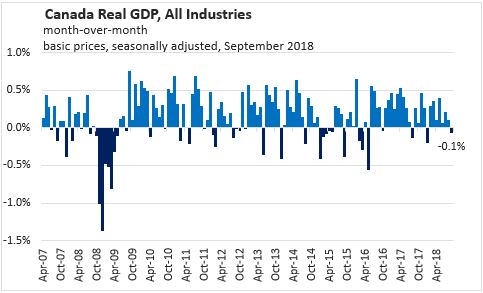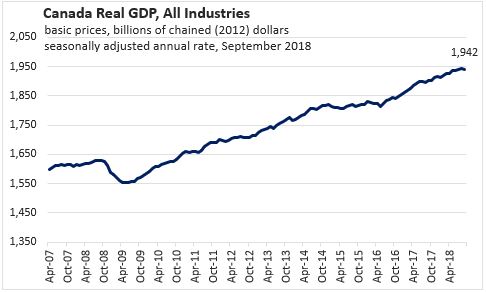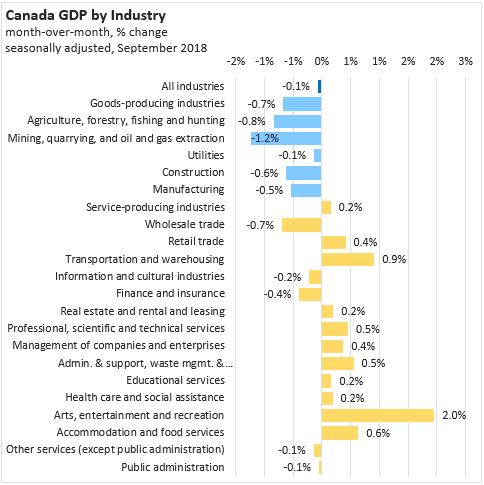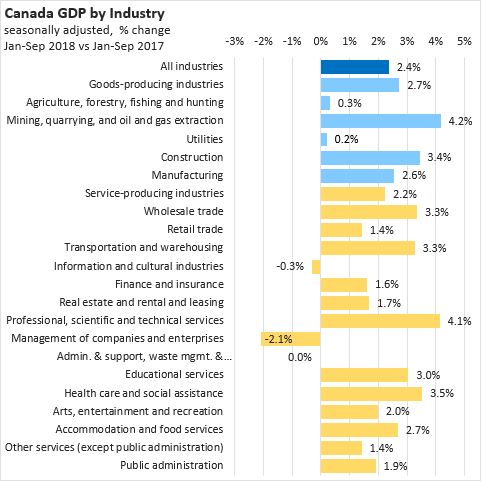The Economics and Statistics Division maintains archives of previous publications for accountability purposes, but makes no updates to keep these documents current with the latest data revisions from Statistics Canada. As a result, information in older documents may not be accurate. Please exercise caution when referring to older documents. For the latest information and historical data, please contact the individual listed to the right.
<--- Return to Archive
For additional information relating to this article, please contact:
November 30, 2018CANADA GDP BY INDUSTRY, SEPTEMBER 2018 Real GDP in Canada declined 0.1 per cent in September following seven consecutive months of growth. The monthly decline was mainly due to lower output across all of the goods producing industries. Most service producing sectors grew to partially offset declines in the goods producing sector. Overall, 10 of the 20 industrial sectors grew in September. Compared to September 2017, the Canadian economy is 2.1 per cent larger with an annualized value of $1,942 billion (chained 2012 dollars).


The output of the goods-producing industries was down 0.7 per cent in September. The mining, quarrying and oil and gas extraction sector declined on lower oil and gas extraction. Conventional oil and gas extraction declined 2.3 per cent, which more than offset the previous four monthly increases, while non-conventional oil extraction declined partly due to maintenance shutdowns and lower crude bitumen production in Alberta. Mining and quarrying increased due to increases in metal ore mining, after lower copper and nickel production in August. Manufacturing declined 0.5 per cent with lower non-durable manufacturing (food, chemical, and petroleum and coal products) while durable manufacturing was essentially unchanged from August. Construction was down 0.6 per cent for the fourth consecutive month on lower residential, repair, and engineering construction. Non-residential construction grew 0.4 per cent led by industrial and commercial construction. Utilities declined 0.1 per cent.
Service-producing industries output grew 0.2 per cent in September. Transportation and warehousing grew 0.9 per cent in September led by postal services and couriers. Retail trade rose 0.4 per cent following three months of decline, with most subsectors posting increases in September. Wholesale trade declined 0.7 per cent, offsetting the previous two months of growth. The finance and insurance sector declined 0.4 per cent following increased activity in August. The public sector was up 0.1 per cent with increases in education and health care.

Canada's real GDP was 2.4 per cent higher in January-September 2018 than in the same period last year. Year-to-date growth was 2.7 per cent in the goods-producing sector, with all subsectors reporting positive growth led by mining, quarrying, and oil and gas extraction (+4.2 per cent). Services are up 2.2 per cent compared to January-September 2017, with the strongest growth in professional, scientific and technical services (+4.1 per cent), and health care and social assistance (+3.5 per cent). For the first nine months of 2018, lower activity occurred in information and culture (-0.3 per cent) and management of companies and enterprises (-2.1 per cent).

Statistics Canada. Table 36-10-0434-01 Gross domestic product (GDP) at basic prices, by industry, monthly (x 1,000,000)
<--- Return to Archive